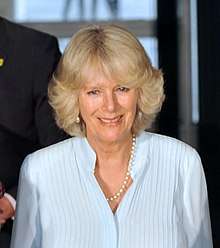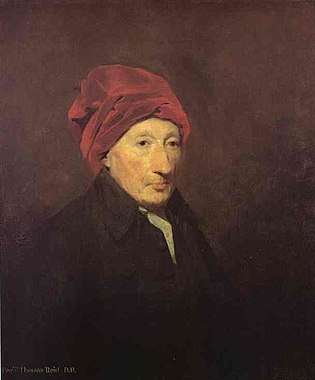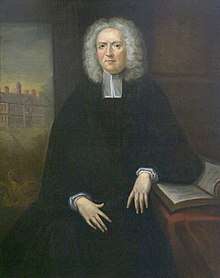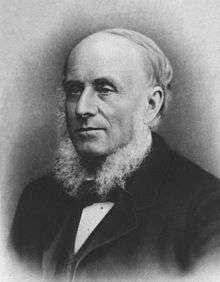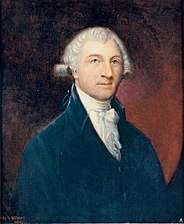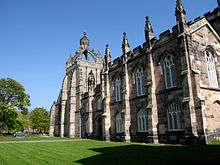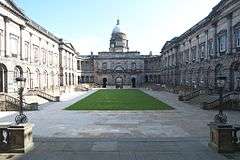University of Aberdeen
Coordinates: 57°09′54″N 2°06′00″W / 57.165°N 2.100°W
 | |
| Latin: Universitas Aberdonensis | |
| Motto | Initium sapientiae timor domini (Latin) |
|---|---|
Motto in English | The fear of the Lord is the beginning of wisdom |
| Type |
Public research university Ancient university |
| Established | 1495[1] |
| Endowment | £45.8 million (as of 31 July 2017)[2] |
| Budget | £222.5 million (2016–17)[2] |
| Chancellor | The Duchess of Rothesay |
| Rector | Maggie Chapman |
| Principal | George Boyne |
Academic staff | 1,114 (2016)[2] |
Administrative staff | 1,400 (2016)[2] |
| Students | 14,150 (2016/17)[3] |
| Undergraduates | 10,210 (2016/17)[3] |
| Postgraduates | 3,940 (2016/17)[3] |
| Location | Aberdeen, Scotland, UK |
| Campus | College town |
| Colours |
(university colours) |
| Affiliations | |
| Mascot | Angus the Bull |
| Website |
www |
|
| |
The University of Aberdeen (abbreviated as Aberd. in post-nominals) is a public research university in Aberdeen, Scotland. It is an ancient university founded in 1495 when William Elphinstone, Bishop of Aberdeen and Chancellor of Scotland, petitioned Pope Alexander VI on behalf of James IV, King of Scots to establish King's College,[4] making it Scotland's third-oldest university and the fifth-oldest in the English-speaking world. Today, Aberdeen is consistently ranked among the top 200 universities in the world[5] and is ranked within the top 30 universities in the United Kingdom.[6][7] Aberdeen was also named the 2019 Scottish University of the Year by The Times and Sunday Times Good University Guide.[8]
The university as it is currently comprised was formed in 1860 by a merger between King's College and Marischal College, a second university founded in 1593 as a Protestant alternative to the former. The university's iconic buildings act as symbols of wider Aberdeen, particularly Marischal College in the city centre and the crown steeple of King's College in Old Aberdeen. There are two campuses; the predominantly utilised King's College campus dominates the section of the city known as Old Aberdeen, which is approximately two miles north of the city centre. Although the original site of the university's foundation, most academic buildings were constructed in the 20th century during a period of significant expansion. The university's Foresterhill campus is next to Aberdeen Royal Infirmary and houses the School of Medicine and Dentistry as well as the School of Medical Sciences. Together these buildings comprise one of Europe's largest health campuses.[9] The annual income of the institution for 2016–17 was £222.5 million of which £61.0 million was from research grants and contracts, with an expenditure of £229.0 million.[2]
Aberdeen has approximately 13,500 students from undergraduate to doctoral level, including many international students. An abundant range of disciplines are taught at the university, with 650 undergraduate degree programmes offered in the 2012-13 academic year. Many important figures in the field of theology were educated at the university, particularly in its earlier history, giving rise to the Aberdeen doctors in the 17th century and prolific enlightenment philosopher Thomas Reid in the 18th. Five Nobel laureates have since been associated with Aberdeen.[10]
History
King's and Marischal Colleges
.jpg)
The first university in Aberdeen, King's College, formally The University and King's College of Aberdeen (Collegium Regium Abredonense), was founded in February 1495 by William Elphinstone, Bishop of Aberdeen, Chancellor of Scotland, and a graduate of the University of Glasgow drafting a request on behalf of King James IV to Pope Alexander VI resulting in a Papal Bull being issued.[4] The university, modelled on that of the University of Paris and intended principally as a law school, soon became the most famous and popular of the Scots seats of learning, largely due to the prestige of Elphinstone and his friend, Hector Boece, the first principal. Despite this founding date, teaching did not start for another ten years, and the University of Aberdeen celebrated 500 years of teaching and learning in 2005.
Following the Scottish Reformation in 1560, King's College was purged of its Roman Catholic staff but in other respects was largely resistant to change. George Keith, the fifth Earl Marischal was a moderniser within the college and supportive of the reforming ideas of Peter Ramus.[11] In April 1593 he founded a second university in the city, Marischal College. It is also possible the founding of another college in nearby Fraserburgh by Sir Alexander Fraser, a business rival of Keith, was instrumental in its creation. Aberdeen was highly unusual at this time for having two universities in one city: as 20th-century University prospectuses observed, Aberdeen had the same number as existed in England at the time (the University of Oxford and University of Cambridge).

Initially, Marischal College offered the Principal of King's College a role in selecting its academics, but this was refused - the first blow in a developing rivalry. Marischal College, in the commercial heart of the city (rather than the ancient but much smaller collegiate enclave of Old Aberdeen), was quite different in nature and outlook. For example, it was more integrated into the life of the city, such as allowing students to live outwith the College. The two rival colleges often clashed, sometimes in court, but also in brawls between students on the streets of Aberdeen.
As the institutions put aside their differences, a process of attempted (but unsuccessful) mergers began in the 17th century. During this time, both colleges made notable intellectual contributions to the Scottish Enlightenment. Both colleges supported the Jacobite rebellion and following the defeat of the 1715 rising were largely purged by the authorities of their academics and officials.
The University of Aberdeen's creation
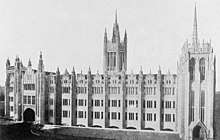
The nearest the two colleges had come to full union was as the "Caroline University of Aberdeen", a merger initiated by Charles I of Scotland in 1641. Following the civil conflicts of the Wars of the Three Kingdoms, a more complete unification was attempted following the ratification of Parliament by Oliver Cromwell during the interregnum in 1654. This united university survived until the Restoration whereby all laws made during this period were rescinded by Charles II and the two colleges reverted to independent status.[12] Charles I is still recognised as one of the university's founders, due to his part in creating the Caroline University and his benevolence towards King's College.[13] Further unsuccessful suggestions for union were brought about throughout the 18th and early 19th centuries.[12]
The two universities in Aberdeen merged on 15 September 1860 in accordance with the Universities (Scotland) Act 1858, which also created a new medical school at Marischal College. The 1858 Act of Parliament stated the "united University shall take rank among the Universities of Scotland as from the date of erection of King's College and University." The university is thus Scotland's third oldest and the United Kingdom's fifth oldest University.
The modern university
The relationship of the two ex-college campuses has changed over the years. While at the time of unification each had approximately equal numbers of students, buildings at Marischal College began to be expanded in the late-19th century with a significant rebuilding effort completed in 1906. In the 20th century, the university expanded greatly, particularly at King's College. New buildings were constructed on the land around King's College throughout the 20th century. Initially, these were built to match the ancient buildings (e.g. the New King's lecture rooms and Elphinstone Hall), but later ones from the 1960s onward were constructed in brutalist style. Meanwhile, the Foresterhill campus began to train medical students in the 1930s next to Aberdeen Royal Infirmary.

During the mid-20th century departments which had been at Marischal College moved into one of these new buildings (most at King's College) and by the late 20th-century Marischal College had been abandoned by all but the Anatomy Department, a graduation hall and the Marischal Museum (Marischal College has now been restored as the headquarters of Aberdeen City Council). Following extensive fundraising, a £57 million new university library (the Sir Duncan Rice Library) opened in autumn 2011 at the King's College campus to replace the outgrown Queen Mother Library[14] and was officially opened by the Queen in September 2012.[15] Today, most students spend most of their time in modern buildings which provide up-to-date facilities for teaching, research and other activities such as dining. However, the old buildings at King's College are still in use as lecture and tutorial rooms and accommodation for various academic departments.
Campuses
The original buildings of both colleges which united to form the university are much admired architectural features of Aberdeen. The main campus is now at King's College, where the original buildings are still in use in addition to many newer buildings of largely modernist style. A second campus at Foresterhill houses the School of Medicine and Dentistry.[16] In addition, there are smaller facilities at other sites such as the Royal Cornhill Hospital to the west of the city centre, and the Rowett Institute in Bucksburn.
King's College

The King's College campus covers an area of some 35 hectares around the ancient King's College buildings and the High Street. It hosts around two-thirds of the university's built estate and most student facilities, and lies 2 miles north of Aberdeen city centre.[16] The university does not own all the buildings on the "campus" which also include private houses, shops and businesses (although many of these rely heavily on custom from the university community) and it is best thought of as a district of the city dominated by the university. It can be reached from the city centre by bus routes 1, 2, 13, 19 and 20 operated by First Aberdeen and from northern Aberdeenshire or the bus station at Union Square by various routes operated by Stagecoach Bluebird.

The historic King's College buildings form a quadrangle with interior court, two sides of which have been rebuilt and expanded with a library wing in the 19th century. The Crown Tower and the Chapel, the oldest parts, date from around 1500. The Crown Tower is surmounted by a structure about 40 ft (12 m) high, consisting of a six-sided lantern and royal crown, both sculptured, and resting on the intersections of two arched ornamental slips rising from the four corners of the top of the tower. This crown, also known as the "Crown of Kings", frequently acts as a symbol of the university. The choir of the chapel contains original oak-canopied stalls, miserere seats, and lofty open screens in the French flamboyant style. They were preserved by the college's Principal during the Reformation, who fought off local barons who had attacked the nearby St Machar's Cathedral. The library wing was converted into an exhibition and conference venue in the 1990s and today also houses the university's Business School.
The first of the modern age of construction in the King's campus began with the construction in 1913 of the New Building (now known as "New King's"), largely in a similar architectural style to the old buildings. New King's groups to form a yet larger quadrangle-like green for the campus also bordered by the High Street, King's and Elphinstone Hall, a traditional 1930 replacement for the Great Hall. The Elphinstone Hall was subsequently used as a dining facility but is now used for graduations, examinations, fairs, and other large university events.
However, most students and staff spend relatively little time in these historic buildings, with a large number of modern ones housing most facilities and academic departments. Most date from the second half of the 20th century. Some of these echo the existing architecture of Old Aberdeen, such as the Fraser Noble Building with its distinctive concrete crown designed to resemble the one adorning King's College. Other buildings were constructed of stone in the 1950s (e.g. the Taylor Building and Meston Building). A number of other buildings are designed in the brutalist style, such as the Arts Lecture Theatre and adjoining William Guild Building, opened in 1969 to house the School of Psychology. Also on the site is the Cruickshank Botanic Garden which was presented to the university in 1899 and is open to the public.
The most recent building on campus is the Sir Duncan Rice Library, completed in 2011 and designed by Danish architects Schmidt Hammer Lassen. It was officially opened by Queen Elizabeth II in September 2012 and named after Duncan Rice, a previous Principal of the university.[15] This seven-storey tower, clad in zebra-like jagged stripes of white and clear glass, replaced the smaller Queen Mother Library as the university's main library and can be seen prominently from the entire campus and much of the city. It is open to the public and outstanding views of the city and coastline are available from the upper floors. In addition to expanded facilities it also houses public exhibition space and the university's historic collections, comprising more than a quarter of a million ancient and priceless books and manuscripts collected over five centuries since the university's foundations.[17] Other libraries are in the Taylor Building on the same campus (for law books and materials) and at Foresterhill (for medicine and medical sciences). The university's library service (i.e. including all libraries) holds over one million books.
Marischal College
.jpg)
Marischal College is a neo-Gothic building, having been rebuilt in 1836-41, and greatly extended several years later. Formerly an open three-sided court, the college now forms a quadrangle as additions to the buildings were opened by King Edward VII in 1906 and form the current facade from Broad Street. The building is widely considered to be one of the best examples of neo-Gothic architecture in Great Britain; the architect, Alexander Marshall Mackenzie was a native of Aberdeen as well as an alumnus of the university. The Mitchell Tower at the rear is named for the benefactor (Dr Charles Mitchell) who paid for the graduation hall. The opening of this tower in 1895 was part of celebrations of the 400th anniversary of the university.
Until 1996, Marischal College housed the Department of Molecular and Cell Biology, which had been there for many decades. From 1996, the department moved to Kings College campus and Foresterhill campus. Teaching no longer takes place at Marischal College, with many of the departments formerly based there having moved to King's College some decades previously. While graduations and other events (e.g. concerts) took place in the cathedral-like Mitchell Hall in the north wing, for many years much of the building (including the frontage to the street) was derelict. A restoration project was completed in 2011 and restored the building and its ornamentation. The Broad Street frontage is now on long-term lease to Aberdeen City Council and forms the administrative headquarters for the city, replacing the ageing St. Nicholas House across the street.[18] The project provided modernized public facilities and office accommodation for the Council as well as cosmetic rejuvenation, and involved the demolition and reconstruction of internal spaces while retaining and restoring the outer walls and windows. The university controls the north wing of the building containing the Marischal Museum and Mitchell Hall which was used in the past for graduation and other academic ceremonies.[16] Graduations take place at Elphinstone Hall at King's College.
Other campuses
Doha, Qatar
A new state of the art campus has been established in Doha, Qatar since May 2017. They have expanded their School of Business to Qatar. The courses currently offered are Accounting & finance and Business Management. The first batch started on the 10 September 2017. The university requirements are the same as those in the Kings College Campus which are A*ABB to AAAB. These students will be the first ones to graduate at a campus abroad. The current dean of the college is Brian Buckley.
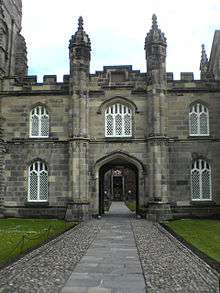
Foresterhill
The Foresterhill site contains the university's School of Medicine and Dentistry, medical library and associated modern buildings for teaching and research. It is at Foresterhill, in Aberdeen's West End. It became part of the university's holdings in 1938 following the move of the Medical School and forms part of a modern teaching hospital complex alongside the Aberdeen Royal Infirmary. The 41 hectare site is split between the university (owning around a third) and NHS Grampian.[16]
Hilton
A small campus at Hilton became part of the university estate following a merger in 2001 between the university and the Aberdeen campus of the Northern College, and temporarily became home to the university's Faculty of Education. It was less than a mile southwest of King's College campus.[16] Following the renovation of the MacRobert Building at King's College to house the School of Education (completed in 2005), the Hilton campus was closed and sold to developers.[19] The campus was demolished and the land is now occupied by a residential development called "The Campus".
Organisation and administration
Governance
In common with the other ancient universities in Scotland, the university's structure of governance is largely regulated by the Universities (Scotland) Acts. This gives the university a tripartite constitution comprising the General Council of senior academics and graduates, the University Court responsible for finances and administration, and the Academic Senate (Senatus Academicus)--the university's supreme academic body.

There are correspondingly three main officers of the university. It is nominally headed by the Chancellor, a largely ceremonial position traditionally held by the Bishop of Aberdeen but divorced from the see as a result of the Scottish Reformation and holders are now elected for life by the General Council. There is also a rector of the university, who chairs the University Court and is elected by the students for a three-year term to represent their interests.
The administrative head and chief executive of the university is its principal and vice chancellor. The principal acts as chair of the Senatus Academicus, and his status as vice chancellor enables him to perform the functions reserved to the chancellor in the latter's absence, such as the awarding of degrees.
Chancellor
The chancellor is the nominal head of the university. The chancellor since 2013 is Camilla, Duchess of Rothesay.[20] She is the first female chancellor of the university. The Chancellor, or, if necessary, his or her deputy, confers degrees on graduates and chairs the university's General Council.
Lord Rector
The rector of the university has been—since 1860—elected by the students to serve a three-year term of office; before that, the office was appointed. His duties are to chair meetings of the University Court and to represent student views on that body. In November 2014, a new rector was elected by the student body of the university, Maggie Chapman, co-convenor of the Scottish Green Party.[21]
Principal and Vice-Chancellor
The principal and vice-chancellor of the university is Professor George Boyne. He joined the university on August 1, 2018.
Colleges and faculties
The university is divided into three colleges, which are further separated into a number of academic schools and other institutions (e.g. graduate schools, research institutes). These colleges are equivalent to faculties at other universities. Some large schools are sub-divided into departments (e.g. the Department of Archaeology is part of the School of Geosciences, which is part of the College of Physical Sciences).
The Centre for Lifelong Learning is not part of any of the colleges and provides adult-education courses to the general public, even for those without the academic qualifications usually needed for admission to the university. Some of these courses lead to the award of a degree or another formal sub-degree qualification. In addition, numerous administrative departments support the university's activities.
|
and is supported by:
|
|
|
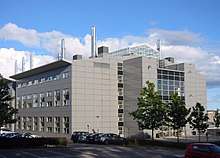 Institute of Medical Sciences, Aberdeen
Institute of Medical Sciences, Aberdeen Chemistry Department
Chemistry Department Cruickshank Building
Cruickshank Building Edward Wright Building
Edward Wright Building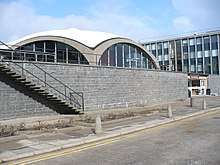 Fraser Noble Building
Fraser Noble Building Geography Department
Geography Department History Department
History Department Faculty of Education
Faculty of Education Zoology Building
Zoology Building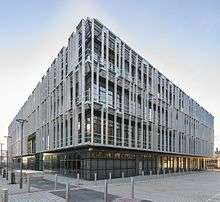 The Rowett Institute
The Rowett Institute King's Pavilion
King's Pavilion A mosaic of the University of Aberdeen coat of arms on the floor of King's College
A mosaic of the University of Aberdeen coat of arms on the floor of King's College
Symbols of the university
The university's coat of arms is an integral part of the current logo, which along with the colours burgundy and white, is used extensively on campus signage, printed materials, and online.

Coat of arms
The university's coat of arms incorporates those of the founders and locations of the two colleges it is derived from. In the top left quadrant are the arms of the burgh of Old Aberdeen, with the addition of a symbol of knowledge being handed down from above. Top right are those of George Keith, the fifth Earl Marischal. Bottom left are those of Bishop William Elphinstone.[22] The bottom right quarter is a simplified version of the three castles which represent the city of Aberdeen [23] (this symbol of the city also appears prominently on the arms of The Robert Gordon University).
Motto
The motto of the University of Aberdeen is Initium Sapientiae Timor Domini, which translates from Latin as "The beginning of wisdom is fear of the Lord". It is a quote from the Old Testament of the Bible, Psalm 111, verse 10. It also appears in the Book of Proverbs (9:10). The motto can be seen at the archway beside New King's on the High Street at the King's College campus, as well as other campus locations and in formal settings such as on graduation certificates.
Tartan
A university tartan was created in 1992 as part of the celebrations for the 500th anniversary of the university which took place in 1995. The tartan was designed by the Weavers Incorporation of Aberdeen and Harry Lindley and incorporates colours from the university's coat of arms.[24]
Academic dress
_(imp-cswc-GB-237-CSWC47-LS5-1-004).jpg)
Aberdeen shared with the other ancient universities the wearing of scarlet gowns (toga rubra) for undergraduates, but by the middle of the twentieth century its use amongst the students had faded.[25] Academic dress is usually worn only at formal occasions, such as at graduation, Founder's Day, or academic processions which take place for ceremonial reasons. For undergraduate degrees (e.g. MA, BSc, LLB etc.), a long black gown is worn with a hood of black silk and lined with silk in a colour which varies depending on discipline. For example, the lining is white silk for all Master of Arts degrees, green silk for Bachelor of Science in pure sciences, and crimson silk for MBChB. A black mortarboard is also worn. For master's degrees (e.g. MSc, MLitt etc.) a long black gown is worn, with a white silk hood lined in a colour that varies by discipline. For PhD, the doctor's scarlet robe is worn with black facings and sleeve lining, along with a black "John Knox" cap. For other doctoral degrees (e.g. EdD, LLD etc.), the scarlet robe has facings and sleeve linings in a different colour.
Academic profile
Rankings and reputation
Global rankings | ||
| ARWU[26] (2018) | 201-300 | |
|---|---|---|
| CWTS Leiden[27] (2018) | 105 | |
| QS[28] (2019) | 172= | |
| THE[29] (2019) | 158 | |
| Complete[30] (2019) |
28 | |
| The Guardian[31] (2019) |
51 | |
| Times / Sunday Times[32] (2019) |
26 | |
Student life
As of 2016/17 the university had 14,150 students, of which 3,940 were postgraduates.[3] In 2009/10 students represented 120 different countries with about 46% men, 54% women. Of all of undergraduates, 19% were mature students (i.e. aged 25 years or more). The university has more than 550 different undergraduate degree programmes and more than 120 postgraduate taught programmes.[10]
Student representation

The student body is represented by a students' association known as Aberdeen University Students' Association (AUSA). Additionally, the elected Rector of the University of Aberdeen serves along with the rector's assessor and AUSA president as a students' representatives on the University Court.
AUSA does not operate a traditional student's union, instead operating out of a university building, Johnston, helping to support students and provide events and studying space. A large student's union formerly occupied an impressive granite building on the corner of Gallowgate and Upperkirkgate in the city centre, but it closed in 2003. A second, smaller union opened at nearby Littlejohn Street a couple of years later, but by 2010 it too had closed.
The organisation has been involved in the creation of "The Hub", a university-owned dining and social centre created by an extensive renovation of the former Central Refectory at the King's College campus. It provides facilities for the whole university community (students and staff) and opened in 2006. A more traditional social space, the Butchart Student Centre, opened in 2009. It acts as the HQ of the Students' Association and provides a wide range of student facilities, but due to city council licensing regulations there is no bar. Facilities at the Butchart Centre include a large cafe, second-hand bookstore, facilities for student societies and offices. The Butchart Centre was converted from what had been the campus sports centre before the opening of the Aberdeen Sports Village nearby. AUSA operates out of the Johnston Building.
Student organisations
There are over a hundred clubs and societies formally affiliated with the students' association.[33] The students' association is responsible for sport at the university, which is managed by the Aberdeen University Sports Union, an AUSA committee. All registered students are eligible to join any of these clubs or societies.
The university's oldest student organisation is the Aberdeen University Debater, founded in 1848 as the King's College Debating Society.[34][35][36] The first successful university newspaper, Alma Mater, began under the auspices of the University of Aberdeen Debating Society in 1883. In 1884, the society also took the first steps towards the introduction of a Students' Representative Council under support from Alexander Bain, the then Rector. The creation of the Union in 1895 provided a new debating chamber in Marischal College and the society's first permanent home. The chamber beneath Mitchell Hall in Marischal College is Scotland's oldest purpose-built debating chamber.
Each year a student-led torcher parade is held. First held in 1889, it is the largest of its kind in Europe.[37] Student groups and societies build floats and parade in fancy dress through the city centre to raise money for local charities. Traditionally spectators donate money in the form of coppers, a colloquial term for 1p and 2p coins.
The Aberdeen Future Fund is an alumni fund run by the Development Trust. Since founding in 1998, Aberdeen Future Fund has raised over £2.5 Million of unrestricted funds. Past projects have included a book fund for the Heavy Demand section in the library, providing "Safe Campus" leaflets, contributing to the student hardship fund, providing training mannequins for Clinical Skills, the organ for King's College Chapel, and funding for intramural sports.[38]
University accommodation

Halls of residence are managed by the university. Two large concentrations of University accommodation are provided on the campus in Old Aberdeen and one mile north at the Hillhead Village.
Campus accommodation in the heart of Old Aberdeen consists of self-catered King's Hall and Elphinstone Rd Halls.
The Hillhead Village is located beside Seaton Park, a 20-minute walk or a 5-minute bus ride to King's campus, and comprises a large number of catered and self-catered accommodation across 9 different properties. At the heart of the Hillhead Village is the Head Space. In addition, other student accommodation in the city is owned and operated by private providers such as Unite Group.
Following their first year, the majority of students live in private accommodation off-campus or in privately owned halls of residence. In recent years, rents and availability of accommodation has seen more second and third year students returning to university halls.
The university has a "First-Year Accommodation Guarantee". In 2014-15, the university ran out of rooms and had to resort to temporary accommodation.[39] The university continues to monitor accommodation costs and where possible offers discretionary support to students, to improve access to higher education.[40]
Sports


The students' association is responsible for sport at the university, which is managed by the Aberdeen University Sports Union, an AUSA committee. There are large playing fields at the back of King's College and also Aberdeen Sports Village, a partnership between the University of Aberdeen, Aberdeen City Council and sportscotland. The venue includes a nine-court indoor hall, full-sized synthetic football pitch, synthetic cricket wicket, fitness suite, squash courts and a sports performance lab among other facilities. The development on the site of the former Chris Anderson Stadium, opened on 24 August 2009. An aquatics centre featuring a 10 lane 50 m pool and diving complex opened in 2014.
Aberdeen Sports Village served as one of the official pre-games training venues of the Cameroon Olympic Team prior to the London 2012 Olympic Games.
Music
There are a large number of ensembles at the University of Aberdeen. Some are directed by academic staff, while others are run by students both in and out of the department and include; Balinese Gamelan, Baroque Ensemble, Big Band, Cantores ad Portam, Chapel Choir, Choral Society, Concert Band, Elphinstone Fiddlers, Flute Choir, New Music Ensemble, Steel Pans, String Orchestra, Symphony Orchestra, Viol Consort.
Student media
There are a number of student media organisations at the University of Aberdeen. These include The Gaudie[41] (student newspaper), Granite City TV and Aberdeen Student Radio (ASR).[42]
Notable alumni and academics
Many notable figures have studied at the University of Aberdeen.
Historically, many emminent scientists have studied at the university. See https://www.abdn.ac.uk/alumni/blog/fellows-of-the-royal-society-from-the-university/
Most recently, it has produced several leading figures in the UK Government, including the former Secretary of State for Scotland, Alistair Carmichael, former Chancellor of the Exchequer, Alistair Darling and the former Paymaster General, Tessa Jowell. The former Chief Constable of Police Scotland, Stephen House, is also an alumnus. Additionally, famous businessmen such as Stephen Carter and Will Whitehorn matriculated at UoA. Radio and television personalities such as Nicky Campbell, James Naughtie, Sandy Gall, Glen Oglaza and Derek Rae were also students there.
The university is well known in philosophical and theological circles. Thomas Reid, the founder of the Scottish School of Common Sense, and an important figure in the Scottish Enlightenment, earned his degree from Marischal College. Robert Adamson and theologian William Robinson Clark also went here. Other academics who started here include Robert Brown, Andrew Ross, Colin Campbell, Oliver D. Crisp, James Legge, Arthur Thomson, as well as William Smith the first Provost of what is now the University of Pennsylvania. The College of William and Mary, which is the second-oldest university in the USA, was founded by Marischal College alumnus James Blair. Prizes awarded to alumni include the Lumsden and Sachs Fellowship. American pastor Andrew Brunson, who was imprisoned by the Turkish government, received his PhD in Divinity from the University in 2001.
Alumni of the medical faculty include Patrick Manson, who first proposed malaria was transmitted by mosquito, founder of the tropical medicine field and London School of Hygiene and Tropical Medicine. Manson also found Dairy Farm in 1886, now a leading pan-Asian retailer and a listed company on the London Stock Exchange. The Kai Tak Airport was namesaked after Kai Ho, who along with Patrick Manson and Graeme Cantlie established the Hong Kong College of Medicine for Chinese in 1887, which later became University of Hong Kong in 1911. Sun Yat-Sen was also educated by Aberdeen University alumni at the Hong Kong College of Medicine for Chinese. Peter Shepherd introduced the concept of teaching first aid to civilians. Another Aberdeen graduate, James Cantlie, published Shepherd's lecture notes as "first aid to the injured" following Shepherd's death in the Battle of Isandlwana in 1879.
Ali Smith, the author of the Booker Prize nominated novel Hotel World and the Whitbread Award winning novel The Accidental, took her undergraduate degree here. Contemporary playwright Simon Farquhar; science fiction writer Adam Roberts, Thomas Urquhart and Archibald Forbes are also alumni known in literary circles. George MacDonald, a pioneering figure in the field of fantasy literature and a mentor of fellow writer Lewis Carroll, read for an MA between 1840 and 1845.
Those known in architectural circles include William Thornton, the designer of the United States Capitol and Charles Mitchell who worked with John Dobson and commissioned the elegant art nouveau church of St George's Jesmond from Thomas Ralph Spence.
Other figures include botanists C. H. Gimingham and M. R. Henderson; dermatologist Sir James Galloway; plant pathologist Lawrence Ogilvie; founding professor of the University of Queensland John Lundie Michie; ornithologist J. D. Macdonald; actor Iain Glen; mountaineer Tom Patey; Colonial Secretary of Hong Kong Frederick Stewart; former leader of the Scottish Liberal Democrats, Nicol Stephen; sports broadcaster Tyrone Smith of STV News; sports broadcaster and international rugby player Ian Robertson; Taliban kidnap victim Linda Norgrove; and James Blair, the founder of the College of William & Mary in Williamsburg, Virginia, US; also William Gregg, spy, studied divinity at King's College, executed by hanging 1708; comedian James Veitch; and the first Foreign Minister of the Republic of Kosovo, Skënder Hyseni in 1986.
Richard Dawkins, David Attenborough, Isaac Watts, Denis Law and J.K. Rowling have been awarded an honorary degree from the university.
Nobel Prize winners
- George Paget Thomson, Professor of Natural Philosophy (Physics) at Aberdeen from 1922 to 1930, together with the American physicist Clinton Davisson "for their (independent) experimental discovery of the diffraction of electrons by crystals". (1937)
- John James Rickard Macleod, jointly with Frederick Banting, for the research which led to the development of insulin as a treatment for diabetes. (1923)
- John Boyd Orr, 1st Baron Boyd-Orr, Director of the Rowett Institute and Professor of Agriculture from 1942 to 1945, in recognition of his contribution to the worldwide fight against hunger. (1949)
- Frederick Soddy, Professor of Chemistry at the University of Aberdeen from 1914 to 1919, for his work on radioactivity and isotopes (1921)
- Richard Laurence Millington Synge, biochemist with the Rowett Institute from 1948 to 1967, for the invention of partition chromatography, a technique used in the separation mixtures of similar chemicals that revolutionised analytical chemistry (1952)
See also

- 5677 Aberdonia, minor planet named after the University of Aberdeen
- List of medieval universities
- Ancient universities
References
- ↑ Bulloch, John Malcolm (1895). A History of the University of Aberdeen: 1495-1895. London: Hodder and Stoughton. p. 2. Retrieved 2012-12-20.
- 1 2 3 4 5 "Annual Reports & Accounts 2017" (PDF). University of Aberdeen. Retrieved 21 December 2017.
- 1 2 3 4 "2016/17 Students by HE provider, level, mode and domicile" (CSV). Higher Education Statistics Agency. Retrieved 25 March 2018.
- 1 2 Bulloch, John Malcolm (1895). A History of the University of Aberdeen: 1495-1895. London: Hodder and Stoughton. pp. 18–19. Retrieved 2012-12-20.
- ↑ "University of Aberdeen Rankings". Quacquarelli Symonds. Retrieved 2015-09-04.
- ↑ "Top UK University League Tables and Rankings 2019". Retrieved 2018-07-12.
- ↑ "University Guide 2016 - The Times". nuk-tnl-editorial-prod-staticassets.s3.amazonaws.com. Retrieved 2018-09-26.
- ↑ "University of Aberdeen named Scottish University of the Year | News | The University of Aberdeen". www.abdn.ac.uk. Retrieved 2018-09-21.
- ↑ "Medicine - University of Aberdeen". Times Higher Education (THE). Retrieved 2018-07-12.
- 1 2 "Fast Facts". University of Aberdeen. Retrieved 27 June 2014.
- ↑ "This Noble College: Building on the European tradition". University of Aberdeen. Archived from the original on 8 May 2013. Retrieved 20 November 2010.
- 1 2 "The New Statistical Account of Scotland - Account of the University and King's College of Aberdeen". Electricscotland.com. Retrieved 2010-11-20.
- ↑ "Founders' Day Service". Public Relations, University of Aberdeen, pubrel@abdn.ac.uk. 2004-11-09. Retrieved 2010-11-20.
- ↑ "The Sir Duncan Rice Library". University of Aberdeen. Retrieved 12 July 2014.
- 1 2 "Queen opens new library at Aberdeen University". BBC News. 2012-09-24. Retrieved 2012-12-20.
- 1 2 3 4 5 "Estate Strategy 2002-2007". University Estates Office. Retrieved 2009-08-13.
- ↑ "Press Release: 'Flagship library project to match academic ambitions' leads next phase of University's infrastructure investment". University of Aberdeen. Retrieved 2009-08-13.
- ↑ "Marischal College | About | The University of Aberdeen". www.abdn.ac.uk. Retrieved 2018-07-12.
- ↑ "University seeks "TC" former students and staff for Hilton closing events". University of Aberdeen. 2005-06-10. Retrieved 2010-11-20.
- ↑ "Aberdeen University poised to install Duchess of Rothesay Camilla as new Chancellor". Daily Record. 10 June 2013. Retrieved 11 July 2014.
- ↑ "Maggie Chapman named as new University of Aberdeen rector". BBC News. 14 November 2014. Retrieved 14 November 2014.
- ↑ "University of Aberdeen - Coat of arms (crest) of University of Aberdeen". www.ngw.nl. Retrieved 2017-08-08.
- ↑ "University of Aberdeen - Armorial Tablet". The Heraldry Society of Scotland. Retrieved 2007-08-18.
- ↑ "Tartan Details - Aberdeen University (1992)". The Scottish Register of Tartans. Retrieved 2012-12-20.
- ↑ Cooper, Jonathan (2010). "The Scarlet Gown: History and Development of Scottish Undergraduate Dress" (PDF). Transactions of the Burgon Society,. 10: 8–42. line feed character in
|title=at position 45 (help) - ↑ "Academic Ranking of World Universities 2018". Shanghai Ranking Consultancy. Retrieved 15 August 2018.
- ↑ "CWTS Leiden Ranking 2018 - PP top 10%". CWTS Leiden Ranking 2018. Retrieved 16 May 2018.
- ↑ "QS World University Rankings 2019". Quacquarelli Symonds Ltd. Retrieved 6 June 2018.
- ↑ "World University Rankings 2019". Times Higher Education. Retrieved 26 September 2018.
- ↑ "University League Table 2019". The Complete University Guide. Retrieved 26 April 2018.
- ↑ "University league tables 2019". The Guardian. 29 May 2018. Retrieved 29 May 2018.
- ↑ "The Times and Sunday Times University Good University Guide 2019". Times Newspapers. Retrieved 23 September 2018.
- ↑ "AUSA Societies Union". Aberdeen University Students' Association. Retrieved 11 July 2014.
- ↑ Anderson, R.D The Student Community at Aberdeen: 1860-1939 (AUP)
- ↑ McLaren, C.A. Aberdeen Students 1600-1860 (AUP)
- ↑ Hargreaves, J.D. and Forbes, Angela Aberdeen University 1945-1981: Regional Roles and National Needs (AUP)
- ↑ "125th anniversary of Aberdeen Torcher Parade". University of Aberdeen. Retrieved 2015-11-04.
- ↑ "Giving to Aberdeen". University of Aberdeen. Retrieved 2011-09-03.
- ↑ "Rooms shortage forces university to book new students into hotel". STV News. Retrieved 2015-09-04.
- ↑ https://www.abdn.ac.uk/accommodation/prospective-students/index.php
- ↑ "The Gaudie". gaudie.co.uk. Archived from the original on 21 September 2013. Retrieved 19 September 2013.
- ↑ "Aberdeen Student Radio". University of Aberdeen. Archived from the original on 21 September 2013. Retrieved 19 September 2013.
External links
| Wikisource has the text of the 1921 Collier's Encyclopedia article Aberdeen, University of. |
| Wikimedia Commons has media related to University of Aberdeen. |
